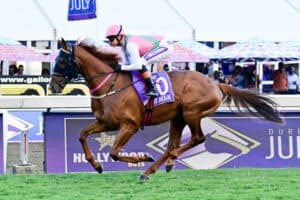Old baking soda and water pain-relief remedy now a no-no.

Many racing fans have been perplexed of late with horses being scratched shortly before the start of races because “total carbon dioxide (TCO2)” levels are “above the international threshold of 36 mmol/L”.
This is something new. Horses dope tested pre-race and action taken without laboratory analysis and verification? No notification of action against trainers? And what the heck is TCO2 anyway?
The answer to that last question is that TCO2 is an effect of what has long been known in the horse world as “milkshaking” or using common baking soda (sodium bicarbonate) and water to alleviate lactic acid buildup in muscles.
TCO2 testing
Globally, racing authorities have started taking a dim view of milkshaking and reckon it’s performance-enhancing if imbibed just before a race.
It allows a horse to move pain-free – which helps them (and people) recover from strenuous exercise and seems a kindness from one perspective – but, importantly, its alkaline effect masks traces of other medication.
TCO2 testing has become fairly common around the world, including locally – alongside testing for other illegal drugs in the equine bloodstream. However, a new, speedier TCO2 surveillance procedure for selected horses was introduced, with no public fanfare, by the National Horseracing Authority in mid-March this year.
The first horse to be scratched minutes before a race was Tyrone Zackey-trained Prime Example, from the Caradoc Gold Cup on 6 April, Champions Day at Turffontein.
The stipes report revealed 55 horses had been TCO2 tested at the meeting, with just that one positive return.
The next milkshake scratching came on 17 April at the Vaal, when 5-10 favourite Miss Hannigan, trained by Fabian Habib, was adjudged over the limit and scratched minutes before Race 2.
Fortunately for the betting market, subsequent favourite Andi’s Girl won the race, but the perils of late scratchings for punters, particularly in exotic bet types, was highlighted.
The next day at Greyville in Durban, Garth Puller-trained 4-1 shot Banzai Pipeline fell foul of the testers.
‘Delay onset of fatigue’
No stern admonishing fingers have been waved at the hapless stables yet. It seems everyone’s still getting used to the procedure. That hasn’t quietened racing angry gang and conspiracy theories, but most observers agree that any measure to further clean up racing is a good thing.
NHA CEO Vee Moodley said in a Turf Talk interview that he hoped to soon have the capacity milkshake test every competing horse pre-race.
The estimable Formgrids, which deals in numbers not words, has seen fit to publish a short explanation of milkshaking, which it says is typically administered “through a nasogastric tube, to reduce the acidity of blood and increase [the] ability to transport oxygen”.
It adds: “The idea behind milkshaking is to delay the onset of fatigue by reducing the buildup of lactic acid in the muscles. Lactic acid is a natural byproduct of intense exercise, and it can lead to muscle fatigue and soreness. By reducing the acidity of the blood, milkshaking is believed to allow horses to perform at a higher intensity for longer periods.”
And concludes: “It’s worth noting that milkshaking is not a substitute for proper training, conditioning and care of horses. It’s a specific technique used in addition to regular training and conditioning programmes and it should only be done under the guidance of a qualified equine professional.”






